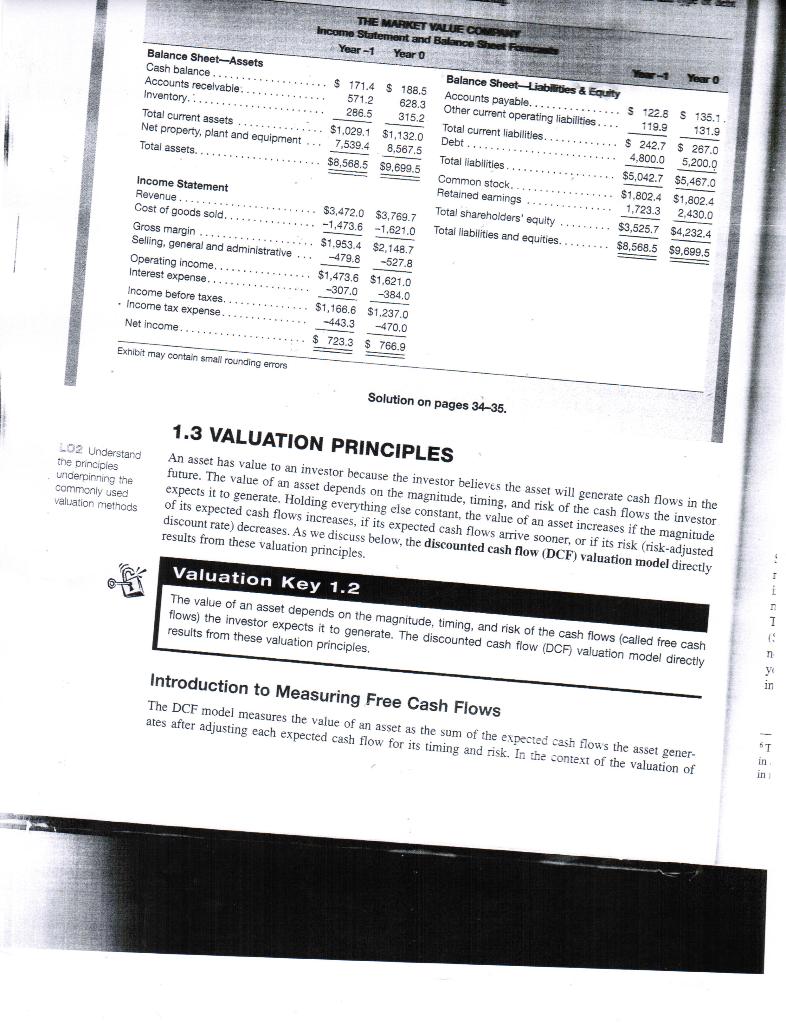Answered step by step
Verified Expert Solution
Question
1 Approved Answer
Prepare a economic balance sheet based on the exhibit that is attached below. Its share price is $12.08 and it has 1,200 shares outstanding. It's
Prepare a economic balance sheet based on the exhibit that is attached below. Its share price is $12.08 and it has 1,200 shares outstanding. It's debt is trading at 102% of market value, It owns $3,000 in unused land. IT creates $3,800 from financing.

Balance Sheet-Assets Cash balance..... Accounts receivable. Inventory.... Total current assets. Net property, plant and equipment... Total assets....... Income Statement Revenue.. Cost of goods sold. Gross margin Selling, general and administrative... Operating income..... Interest expense.. Income before taxes. . Income tax expense... Net income... LO2 Understand the principles underpinning the commonly used valuation methods Exhibit may contain small rounding errors THE MARKET VALUE COMPANY Income Statement and Balance Sheet Ferns Year 0 Year-1 $ 171.4 S 188.5 571.2 628.3 315.2 286.5 $1,029.1 $1,132.0 7,539.4 8,567.5 $8,568.5 $9,699.5 = $3,472.0 $3,769.7 -1,473.6 -1,621.0 $1,953.4 $2,148.7 -479.8 -527.8 $1,473.6 $1,621.0 -307.0 -384.0 $1,166.6 $1.237.0 -443.3 -470.0 $ 766.9. $723.3 Balance Sheet-Liabilities & Equity Accounts payable... Other current operating liabilities.... Total current liabilities. Debt Total liabilities. Common stock. Retained earnings Total shareholders' equity Total liabilities and equities. Solution on pages 34-35. Year O S 122.8 S 135.1. 119.9 131.9 $ 242.7 $267.0 4,800.0 5,200.0 $5,042.7 $5,467.0 $1,802.4 $1,802.4 1,723.3 2,430.0 $3,525.7 $4,232.4 $8,568.5 $9,699.5 1.3 VALUATION PRINCIPLES An asset has value to an investor because the investor believes the asset will generate cash flows in the future. The value of an asset depends on the magnitude, timing, and risk of the cash flows the investor expects it to generate. Holding everything else constant, the value of an asset increases if the magnitude. of its expected cash flows increases, if its expected cash flows arrive sooner, or if its risk (risk-adjusted discount rate) decreases. As we discuss below, the discounted cash flow (DCF) valuation model directly results from these valuation principles. Valuation Key 1.2 The value of an asset depends on the magnitude, timing, and risk of the cash flows (called free cash flows) the investor expects it to generate. The discounted cash flow (DCF) valuation model directly results from these valuation principles. Introduction to Measuring Free Cash Flows The DCF model measures the value of an asset as the sum of the expected cash flows the asset gener- ates after adjusting each expected cash flow for its timing and risk. In the context of the valuation of 6 in ST in in
Step by Step Solution
★★★★★
3.28 Rating (151 Votes )
There are 3 Steps involved in it
Step: 1

Get Instant Access to Expert-Tailored Solutions
See step-by-step solutions with expert insights and AI powered tools for academic success
Step: 2

Step: 3

Ace Your Homework with AI
Get the answers you need in no time with our AI-driven, step-by-step assistance
Get Started


